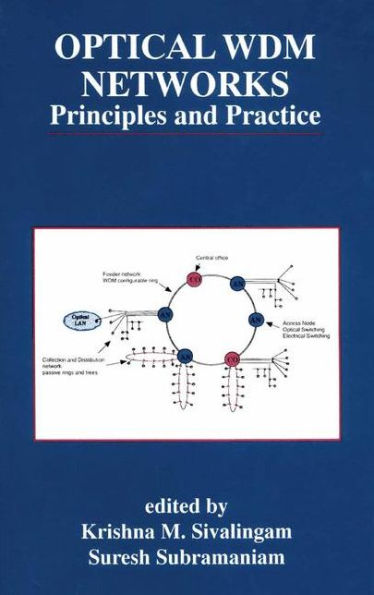Optical WDM Networks: Principles and Practice / Edition 1 available in Hardcover, Paperback

Optical WDM Networks: Principles and Practice / Edition 1
- ISBN-10:
- 1441949798
- ISBN-13:
- 9781441949790
- Pub. Date:
- 12/07/2010
- Publisher:
- Springer US
- ISBN-10:
- 1441949798
- ISBN-13:
- 9781441949790
- Pub. Date:
- 12/07/2010
- Publisher:
- Springer US

Optical WDM Networks: Principles and Practice / Edition 1
Buy New
$169.99Overview

Product Details
| ISBN-13: | 9781441949790 |
|---|---|
| Publisher: | Springer US |
| Publication date: | 12/07/2010 |
| Series: | The Springer International Series in Engineering and Computer Science , #554 |
| Edition description: | 2002 |
| Pages: | 352 |
| Product dimensions: | 6.10(w) x 9.25(h) x 0.24(d) |
Read an Excerpt
Chapter 1: Survey of State-of-the-Art
IntroductionWe are moving towards a society which requires that we have access to information at our finger tips when we need it, where we need it, and in whatever format we need it. The information is provided to us through our global mesh of communication networks, whose current implementations, e.g., today's Internet and asynchronous transfer mode (ATM) networks, do not have the capacity to support the foreseeable bandwidth demands.
Fiber-optic technology can be considered our saviour for meeting our above need because of its potentially limitless capabilities [Mukherjee, 1997], [Cochrane, 1995]: huge bandwidth (nearly 50 terabits per second (Tbps)), low signal attenuation (as low as 0.2 dB/km), low signal distortion, low power requirement, low material usage, small space requirement, and low cost. Our challenge is to turn the promise of fiber optics to reality to meet our information networking demands of the next decade (and well into the next century!).
Thus, the basic premise of the subject on optical wavelength-division multiplexing (WDM) networks is that, as more and more users start to use our data networks, and as their usage patterns evolve to include more and more bandwidth-intensive networking applications such as data browsing on the world wide web (WWW), java applications, video conferencing, etc., there emerges an acute need for very high-bandwidth transport network facilities, whose capabilities are much beyond those that current high-speed (ATM) networks can provide. There is just not enough bandwidth in our networks today to support the exponential growth in user traffic!
Given that a single-mode fiber's potential bandwidth is nearly 50 Tbps, which is nearly four orders of magnitude higher than electronic data rates of a few gigabits per second (Gbps), every effort should be made to tap into this huge opto-electronic bandwidth mismatch. Realizing that the maximum rate at which an end-user, which can be a workstation or a gateway that interfaces with lower-speed subnetworks, can access the network is limited by electronic speed (to a few Gbps), the key in designing optical communication networks in order to exploit the fiber's huge bandwidth is to introduce concurrency among multiple user transmissions into the network architectures and protocols. In an optical communication network, this concurrency may be provided according to either wavelength or frequency [wavelength-division multiplexing (WDM)], time slots [time-division multiplexing (TDM)], or wave shape [spread spectrum, code-division multiplexing (CDM)].
Optical TDM and CDM are somewhat futuristic technologies today. Under (optical) TDM, each end-user should be able to synchronize to within one time slot. The optical TDM bit rate is the aggregate rate over all TDM channels in the system, while the optical CDM chip rate may be much higher than each user's data rate. As a result, both the TDM bit rate and the CDM chip rate may be much higher than electronic processing speed, i.e., some part of an end user's network interface must operate at a rate higher than electronic speed. Thus, TDM and CDM are relatively less attractive than WDM, since WDM unlike TDM or CDM has no such requirement.
Specifically, WDM is the current favorite multiplexing technology for optical communication networks since all of the end-user equipment needs to operate only at the bit rate of a WDM channel, which can be chosen arbitrarily, e.g., peak electronic processing speed. Hence, the major carriers today all devote significant effort to developing and applying WDM technologies in their businesses.
Wavelength-Division Multiplexing(WDM)
Wavelength-division multiplexing (WDM) is an approach that can exploit the huge opto-electronic bandwidth mismatch by requiring that each end-user's equipment operate only at electronic rate, but multiple WDM channels from different end-users may be multiplexed on the same fiber. Under WDM, the optical transmission spectrum (see Fig. 1.1) is carved up into a number of non-overlapping wavelength (or frequency) bands, with each wavelength supporting a single communication channel operating at whatever rate one desires, e.g., peak electronic speed. Thus, by allowing multiple WDM channels to coexist on a single fiber, one can tap into the huge fiber bandwidth, with the corresponding challenges being the design and development of appropriate network architectures, protocols, and algorithms. Also, WDM devices are easier to implement since, generally, all components in a WDM device need to operate only at electronic speed; as a result, several WDM devices are available in the marketplace today, and more are emerging.
Research and development on optical WDM networks have matured considerably over the past few years, and they seem to have suddenly taken on an explosive form, as evidenced by recent publications [Mukherjee, 1997; JSAC98, 1998; JLT96, 1996; JSAC96, 1996; JLT93, 1993; JSAC90, 1990; JHSN95, 1995] on this topic as well as overwhelming attendance and enthusiasm at the WDM workshops during recent conferences: Optical Fiber Communications conference and IEEE International Conference on Communications. A number of experimental prototypes have been and are currently being deployed and tested...
